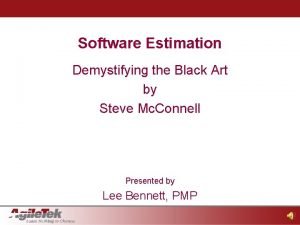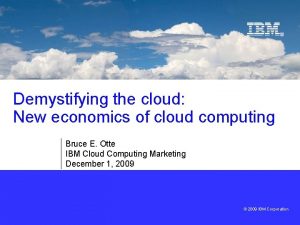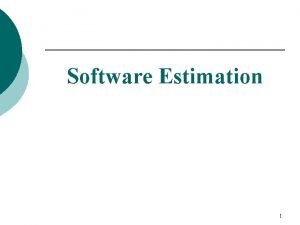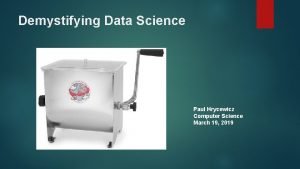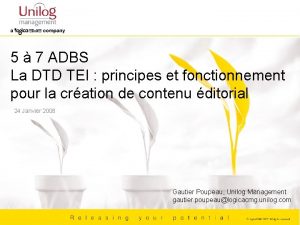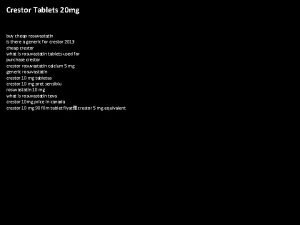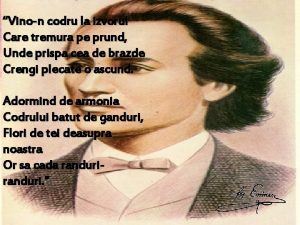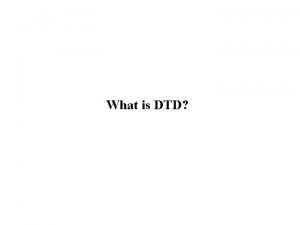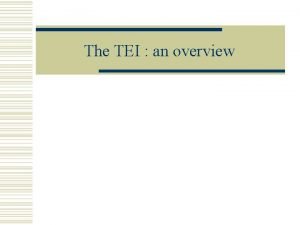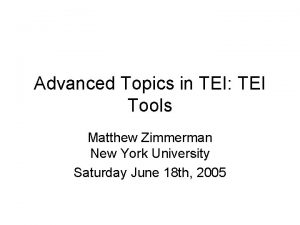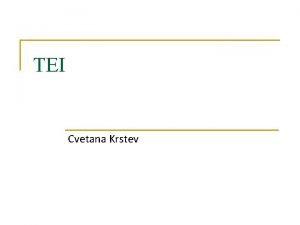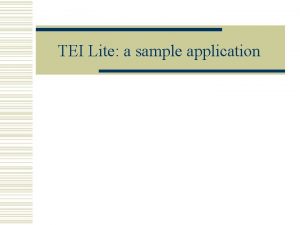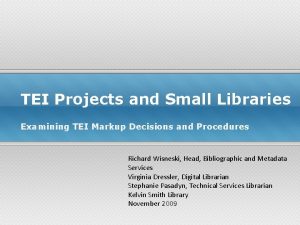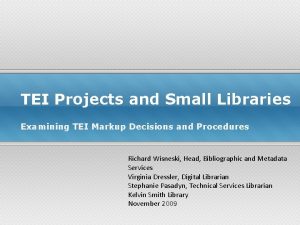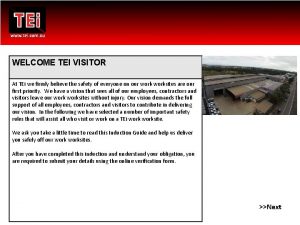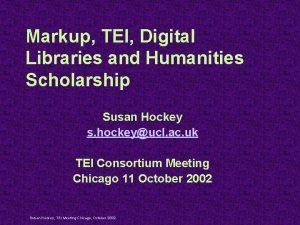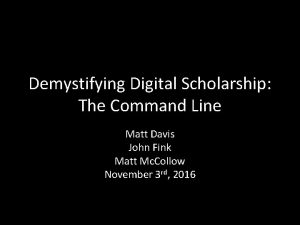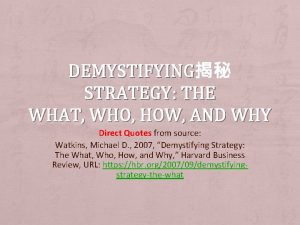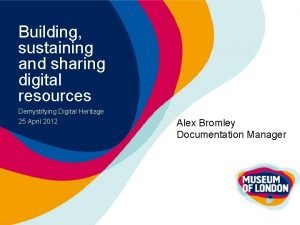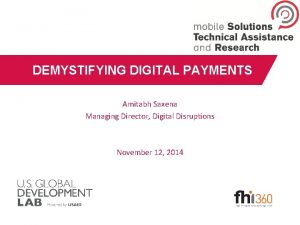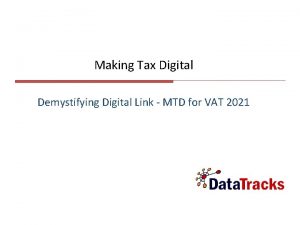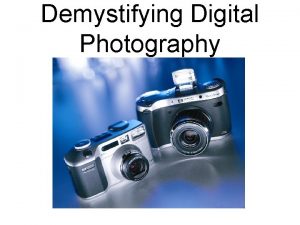Demystifying Digital Scholarship 10 TEI March 9 th















- Slides: 15

Demystifying Digital Scholarship 10: TEI March 9 th, 2017 Matthew Evan Davis Postdoctoral Fellow, Sherman Centre for Digital Scholarship davism 17@mcmaster. ca @medievalmatt

What is TEI? TEI stands for the Text Encoding Initiative. It defines itself as “a consortium which collectively develops and maintains a standard for the representation of texts in digital form. Its chief deliverable is a set of Guidelines which specify encoding methods for machine-readable texts, chiefly in the humanities, social sciences and linguistics. ”

What is TEI Really? TEI is a way to encode both information about a text –metadata – and the content of that text in a way that allows people to do various things with the text despite having only encoded it once.

What is TEI Really? TEI is a way to encode both information about a text –metadata – and the content of that text in a way that allows people to do various things with the text despite having only encoded it once. So what? Why not just put your transcription up as a word file, or pdf, or something and be done with it?

So what? . pdf files, text files, and html, once created, can generally only be used in the original contexts they were created for.

So what? A TEI-encoded text, on the other hand, can be converted to any of the formats mentioned, can be utilized in whole or in part by other projects, and can be searched on across multiple documents easily.

How does TEI do this? TEI is able to do all these things simultaneously because, rather than being tied to a particular piece of software it is actually a XML standard. XML, much like HTML, is built on the concepts of start tags, end tags, and empty elements: <p>The quick brown fox jumped over the lazy dog</p> <p/> The TEI standard can be found at http: //www. teic. org/Guidelines/P 5/.

Terminology The example given in the last slide consists entirely of elements: <p>The quick brown fox jumped over the lazy dog</p> <p/> If you want to additional information to an XML element that is meant to be machine readable, but not readable by humans, you can include what is called an attribute: <p rend=“align(center) case(allcaps)”>The quick brown fox jumped over the lazy dog</p> <p/> The description of each element in the TEI guidelines not only tells you what the intended purpose of the element is, but what attributes can be attached to that element. For the attributes that can attach to the element <p>, browse to http: //www. tei-c. org/release/doc/tei -p 5 -doc/en/html/ref-p. html.

Terminology

How do I actually build a document? > > /> /> /> /> /> This is the smallest TEI document possible: > TEI version="5. 0" xmlns="http: //www. tei-c. org/ns/1. 0<" tei. Header < file. Desc < title. Stmt < title>The shortest TEI Document Imaginable</title < title. Stmt < publication. Stmt< p>First published as part of TEI P 2, this is the P 5 version using a name space. </p < publication. Stmt < source. Desc < p>No source: this is an original work. </p< source. Desc < file. Desc< tei. Header < text < body < p>This is about the shortest TEI document imaginable. </p< body < text < TEI< A TEI document consists of two parts – the metadata about the document, which is contained in a tree under the <tei. Header>, and the actual document itself, which is contained either under a <text> or a <source. Doc> element. .

How do I actually build a document? Everything else you do is a process of checking the guidelines, determining what element matches with what you are trying to transcribe, and applying it accordingly. The underlying structure of the TEI Header can be found at http: //www. teic. org/Vault/P 5/3. 1. 0/doc/tei-p 5 -doc/en/html/HD. html, while the underlying structure for a default text can be found at http: //www. teic. org/Vault/P 5/3. 1. 0/doc/tei-p 5 -doc/en/html/DS. html. Note that the default text structure does not handle every situation that is likely to come up! The Table of Contents for the full Guidelines (at http: //www. tei-c. org/Vault/P 5/3. 1. 0/doc/tei-p 5 -doc/en/html/) can be useful for ferreting out the various ways that your document fits (and doesn’t fit!) TEI as it is written.

Editorial Tools Anything that can edit text can be used to create an XML document. XML-specific tools simply allow you to validate the XML for correctness against the schema, run various programmatic transformations against the document, or autocomplete certain elements. Possible examples (a fuller list comparing features can be found on Wikipedia: https: //en. wikipedia. org/wiki/Comparison_of_XML_editors): Oxy. Gen (https: //www. oxygenxml. com/): academic license (US$99) Xeditor (http: //www. xeditor. com/portal): web-based, pricing by enquiry. Adobe Framemaker (http: //www. adobe. com/products/framemaker. html): commerical license (US$999)

Online Tools TAPAS (http: //tapasproject. org/): designed to “Visualize, Store, and Share Your TEI. ” CWRC-Writer (http: //www. cwrc. ca/projects/infrastructureprojects/technical-projects/cwrc-writer/). Based on a modified version of TEI Lite (http: //www. teic. org/Guidelines/Customization/Lite/) http: //apps. testing. cwrc. ca/editor/dev/index. htm Username: cwrc Password: cwrcy

Displaying, Searching and Working With a TEI Text Since TEI is really just a standard under XML, there are two tools that will let you manipulate the document you’ve just created: XSLT and XQuery. XSLT stands for e. Xtensible Stylesheet Langauge Transformations. It is a language designed to transform XML documents into other formats – other versions of XML, Word Documents, plain text, etc. XQuery is a programming language that can both query and transform collections of data, including TEI documents.

Thank you! Matthew Evan Davis davism 17@mcmaster. ca @medievalmatt
 Poland national anthem lyrics
Poland national anthem lyrics Software estimation demystifying the black art
Software estimation demystifying the black art Demystifying healthcare data governance
Demystifying healthcare data governance Demystifying the cloud
Demystifying the cloud Software estimation demystifying the black art
Software estimation demystifying the black art Paul hrycewicz
Paul hrycewicz Adbs
Adbs Omacor tei
Omacor tei Proscar farmacia tei
Proscar farmacia tei Tei nummer digitalfunk
Tei nummer digitalfunk Flori de tei deasupra noastra
Flori de tei deasupra noastra Internal dtd example
Internal dtd example Tei lece
Tei lece Unique features of digital markets
Unique features of digital markets E-commerce: digital markets, digital goods
E-commerce: digital markets, digital goods 9 komponen kewargaan digital
9 komponen kewargaan digital

